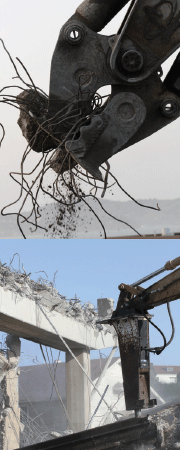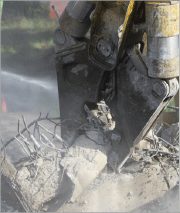FERMA is proud to announce the launch of its new website. We hope you’ll find it serves as a valuable resource to learn more our company, services, and projects.
We welcome any feedback and suggestions. Thanks!
FERMA is proud to announce the launch of its new website. We hope you’ll find it serves as a valuable resource to learn more our company, services, and projects.
We welcome any feedback and suggestions. Thanks!
| Misconception | Fact | |
| 1 | Demolition contractors primarily implode, or “blow up” buildings. | Implosions account for less than 1 percent of all demolition work. |
| 2 | Demolition contractors destroy many structures that should be saved. | Demolition contractors are instrumental in achieving the goals of preservationists. |
| 3 | Demolition contractors don’t participate in the nation’s recycling effort. | The demolition industry was salvaging building elements and materials for reuse long before it was the “ecological thing to do.” |
| 4 | Demolition contractors unnecessarily overcrowd landfills with debris. | The industry is reducing its use of landfills in favor of recycling. |
| 5 | Demolition is an unsophisticated business. | A safe and successful demolition project requires a working knowledge of both construction and the law. |
| 6 | The methods of demolition never change. | Demolition practices today are not only quicker but safer and more cost-effective. |
| 7 | One demolition contractor is basically the same as the next. | Don’t tell that to the owner who has had the misfortune of dealing with an inexperienced contractor. |
| 8 | Demolition is dangerous business. | In the hands of professionals, the danger is controlled. |
| 9 | Demolition is expensive. | Commercial demolition work generally costs less than 2 percent of the replacement cost of the building. |
| 10 | Once a demolition project is completed, the owner’s worries are over. | A project owner cannot “contract away” his responsibility or liability. |
Demolition contractors can strengthen government’s response to natural and man-made disasters by getting highly involved during the planning stages for emergencies, according to Jeff Kroeker, president of the National Demolition Association (NDA), Doylestown, Pa.
During the NDA Annual Convention in San Diego in late March, demolition professionals who were at ground zero in Christchurch, New Zealand, following a magnitude-6.3 quake in 2011 gave presentations. The experiences of the demolition experts and the city’s leadership can provide valuable lessons to others responsible for emergency management, especially in earthquake-prone areas, according to the NDA.
The NDA is intent on alerting communities in the United States that may be unprepared for a Christchurch-like event, says Michael R. Taylor CAE, Executive Director of the association. As a result, the association has formed a Disaster Response Committee, which has prepared a Disaster Response Manpower and Equipment Survey for local and state governments to use to help them prepare in advance to help save lives, facilitate faster response, and avoid the consequences of delayed decision making. The survey is available on the association website, www.demolitionassoication.com, in its new Disaster Response section.
“The U.S. Geological Survey, the science organization of the U.S. government, has predicted with a 99 percent certainty that there will be a similar magnitude earthquake in California in the next 30 years,” says Taylor. “Our Committee, including those experts who have been working in Christchurch for the last two years dealing with everything from downed utilities, lack of food, housing, and power, hazardous materials disposal, and the safe demolition of damaged structures can share some invaluable lessons with other communities needing assistance with disaster planning.”
The NDA website has also made available for public viewing a video produced by Ward Demolition Co. showing the damage of the earthquake, as well as the presentation he made at the convention.
The 1.5 miles of roadway that connects the Golden Gate Bridge with San Francisco, known as Doyle Drive, was closed at 8 a.m. Friday, April 27 until 5 a.m. Monday, April 30 for demolition, making way for a temporary bypass. Eventually, the temporary bypass will be replaced by a more seismically stable structure called the Presidio Parkway, scheduled to open by the end of 2015.
A total of 65,000 tons of concrete was demolished and removed to make way for the temporary bypass.
“This is one of the biggest operations that I’ve ever been involved with,” says David Pang of the California Department of Transportation (Caltrans). “Demolishing 3,300 feet of concrete viaduct in basically less than 24 hours—that’s an amazing feat.”
Doyle Drive is the southern approach to the Golden Gate Bridge that opened along with the Golden Gate Bridge in 1937. It had been identified as one of the most seismically-unsafe roadways in the state of California. Caltrans shut it down and began tearing down pretty much everything between Highway 1 and Marina Boulevard on a Friday evening and reopened the area with a temporary bypass the following Monday morning.
 Several different attachments were used during the Doyle Drive project. Several different attachments were used during the Doyle Drive project. |
“The timeframe was what made this difficult,” says Marc Ferrari, president of Ferma Corp., Mountain View, Calif. “We basically had 24 hours to get three critical spots cleared so they could build the brand new road. We destroyed somewhere around 65,000 tons of concrete and miscellaneous pieces.
“The amount of work for this time frame was absolutely insane,” Ferarri adds. Crews ran three 12-hour shifts in a row to get the demolition work done so the temporary road could built before the Monday morning commute.
During demolition, hundreds of joggers, dog walkers and spectators lined the construction zone to take in the interesting and unusual show. Cheers were heard as giant excavators, their hydraulic arms fitted with various attachments, knocked down Doyle Drive with agility and speed.
In the middle of the 24-hour demolition time frame was Stanley LaBounty, Two Harbors, Minn. Ferma operated 12 different LaBounty attachments on this job. Among the LaBounty attachments in action were metal shears, concrete demolition Universal Processors (UP), large mounted pavement breakers and LaBounty’s newest concrete demolition attachment, the MDP30 (Mobile Demolition Processor).
Ferma utilized a UP 75 to cut girders in the ground as well as a 3000R, a 7500R and a 2000R.
“We couldn’t have done the job without LaBounty products,” states Ferrari. “Their forces were phenomenal. They were cutting columns in single passes.”
An MDP30 was on site to perform the processing needed to drop the sections of the roadway. “The great thing about those big tools is they rotate and they have big jaws, so we were able to get around the 32-inch columns we had out here,” says Ferrari.
Pang says the equipment was unlike anything he had ever seen. “When the equipment started coming in a couple of weeks before we started this operation, we were amazed,” he recalls.
Shears were quickly put to work clipping columns and breaking down the girders. Byron Linn Caltrans says he was surprised at how the shears were able to demolish 4,000 psi (pounds per square inch) concrete. “With this shear, it just crumbles like cookie crumbs,” he says.
Stanley LaBounty provides metal and concrete demolition and recycling attachments for general contractors, scrap metal recyclers, demolition experts, heavy construction engineers and bridge contractors.
 The Doyle Drive project involved processing both concrete and steel. The Doyle Drive project involved processing both concrete and steel. |
“On this job our demolition attachments enabled the operators to work with agility and speed,” says Barb Popoli, president, Stanley Infrastructure Solutions. “Once sites like these are cleared, our metal shears can further process the scrap in preparation for recycling.”
“The demolition portion of the job had to be done in 24 hours so it required they have the right tools on site,” Bob Stuppy, Stanley LaBounty western regional manager, says. “The LaBounty Shears, Universal Processors, MDP and the Stanley MB100EXS breaker worked non-stop allowing the contractor to finish ahead of schedule.”
“I just think overall, crews did an amazing job,” remarks Molly Graham of Caltrans. “It was really like something I’ve never seen before and I don’t think many people have. It was right here in the middle of a national park and it was almost a spectator sport. It was really quite amazing.”